Egypt - "Yes, Wonderful Things" *
January 2008 by Kathi Jacobs
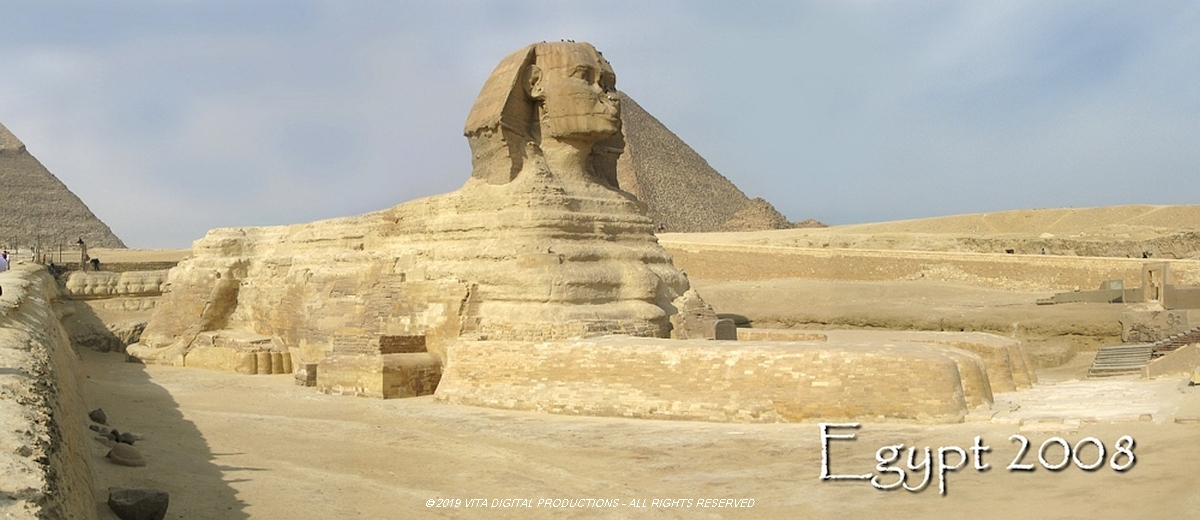
Saturday, 29 December 2007 - It's 5:10 PM and we're now sitting at JFK terminal 4, gate B24, ready for our 6:30 PM flight #986 on Egypt Air nonstop to Cairo. (This is a trip long in the making for us; for many years I've told Wayne how marvelous and intriguing a country is Egypt and I've long been awaiting the chance to share it with him. And finally, here we are...)
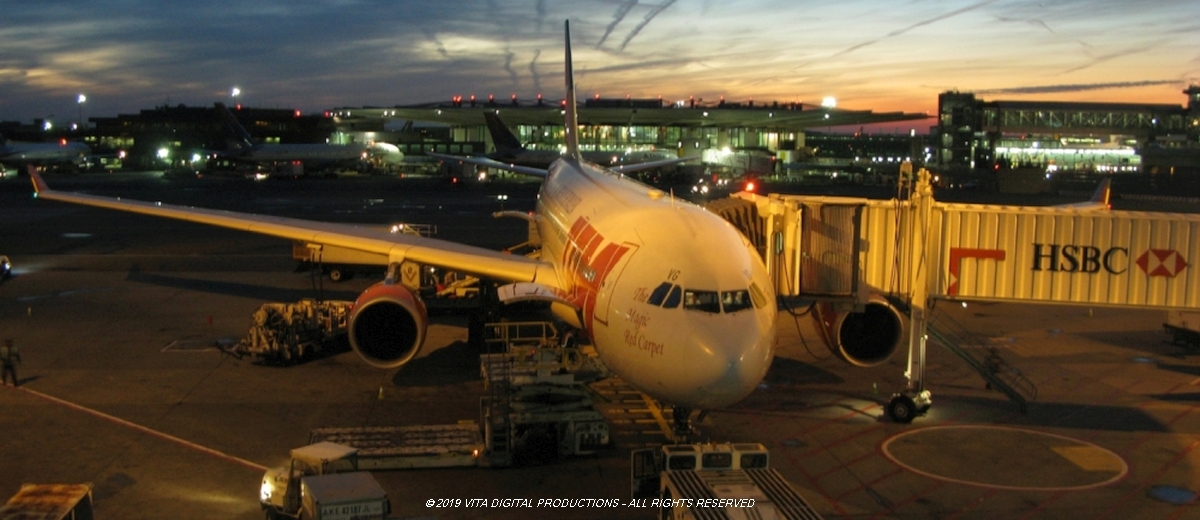
The day has flowed smoothly thus far. We left GSO at 1:03 PM on Delta, arrived LGA at 2:14 PM, on the airport express shuttle at 2:46 PM, and at JFK at 3:20 PM. There were Grand Circle Travel reps just outside the Egypt Air check in counters to greet us and tell us where to leave our checked baggage.
Wayne and I just had a late lunch at au Bon Pain and sailed through security before arriving at our gate. It's full of GCT/OAT travelers, many of whom seem to know one another. There are affable greetings all around and the mood seems to be friendly and happy.
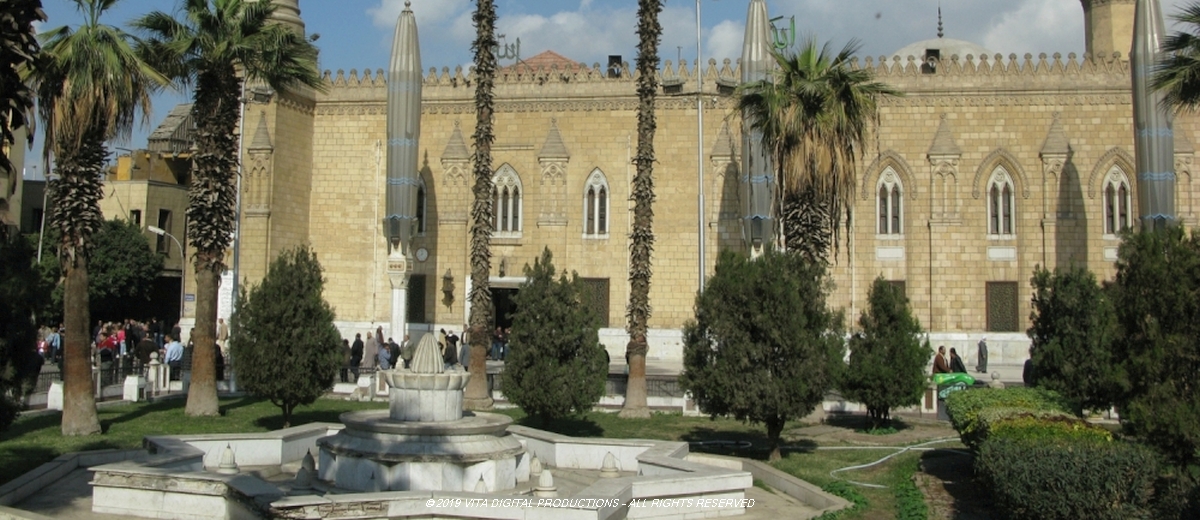
Sunday, 30 December 2007 - 11:45 AM, Cairo - Yesterday's arrival and most events are a blur. It's a long trip and neither of us slept more than a few hours. If not pleasant, at least it was a smooth flight. Egypt Air gave each of us a present.
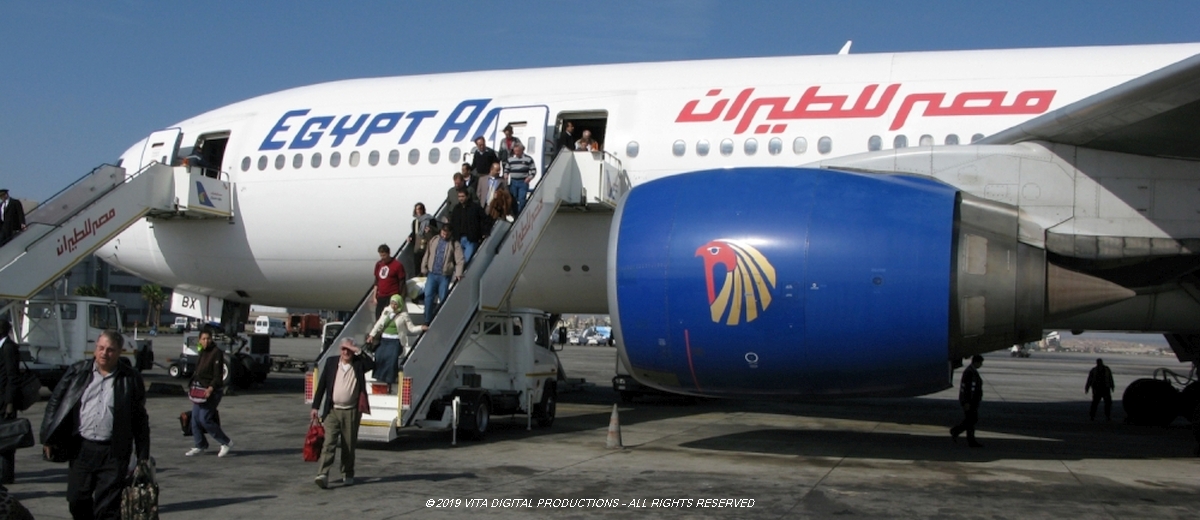
We landed in the desert – such a neat experience! Reached the terminal around noon (30 December 2007.) Retrieving checked baggage was a lengthy process, especially with 134 people in our combined group. Fortunately, we're divided into four groups, or busloads. Our tour leader is Amin Sirag and our driver for our 5 days in Cairo is Amr.
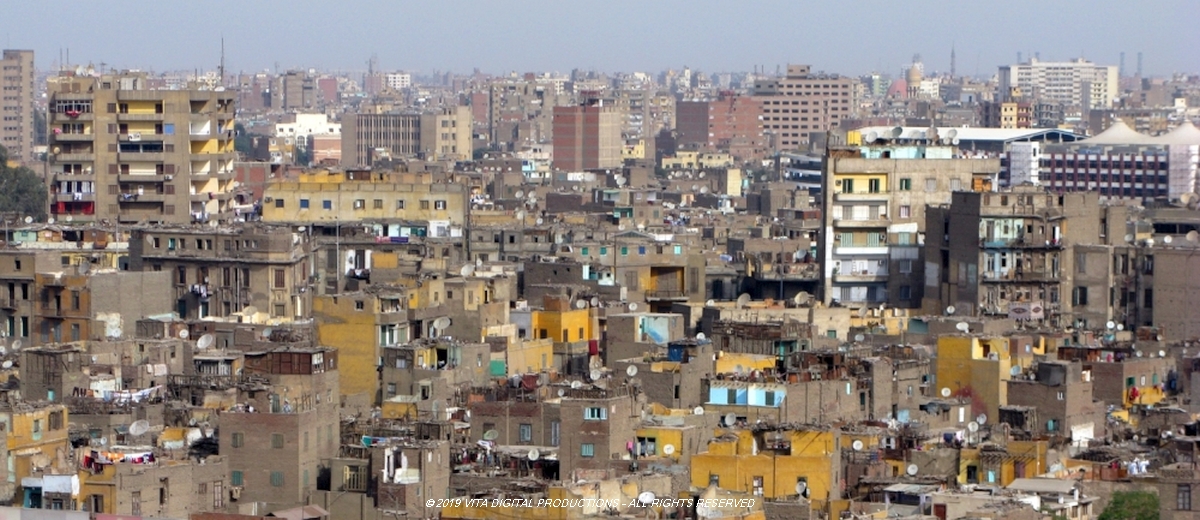
The drive in from the airport to the Ramses Hilton is a distance of 22 km and takes about 40 minutes. And as before when first visiting Egypt fourteen years ago, I was struck by the juxtaposition of modern day Cairo, a teeming city of 11 million people, with the mighty colossus of pharaoh Ramses II.
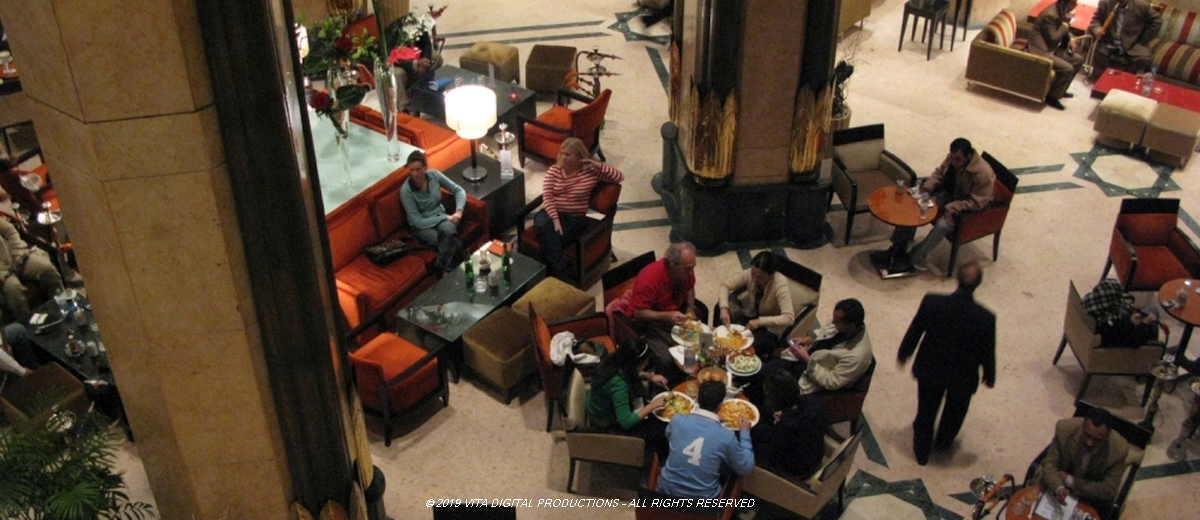
We received our welcome packet, our room keys (room #827) and a drink made from the hibiscus flower. The taste was similar to grape juice, only lighter. We had a few hours of free time, during which Wayne took a nap and I unpacked.
We both showered and changed into fresh clothing for the 6:30 PM reception and seated dinner which followed. It was very pleasant to have dinner with a friend we met from Huntersville NC and her buddy who was from Chicago. The wait staff in the restaurant really hustled and worked on our behalf. Bedtime immediately afterward.
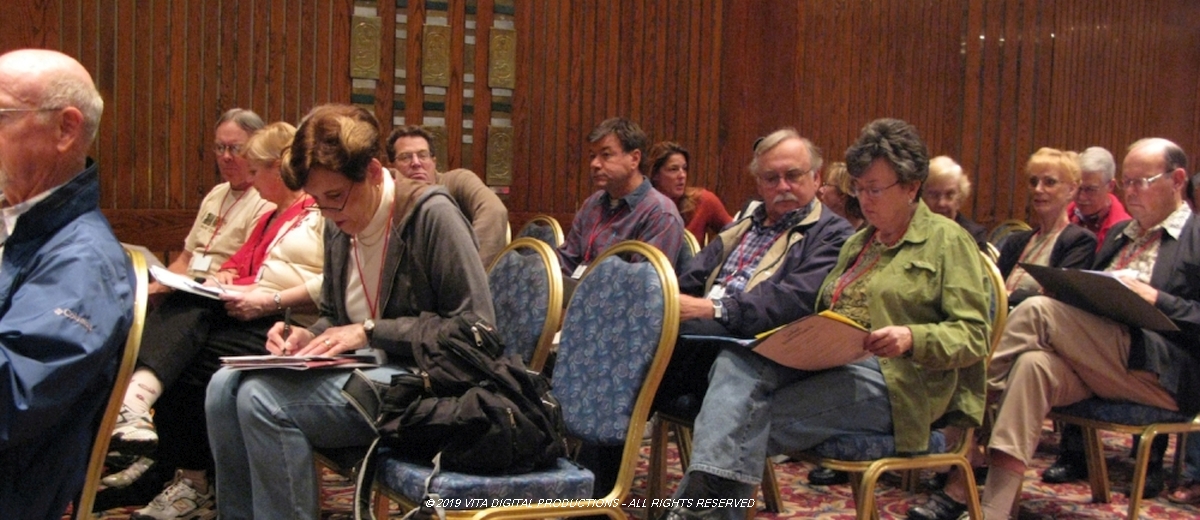
Monday, New Year's Eve 2007 - A very full day! Up at 6:00 AM to shower and dress, then breakfast with a couple from northern CA. We gathered in the ballroom for an orientation meeting at 8:00 AM, at which time each of the four GCT tour leaders imparted valuable information. My head is still spinning!
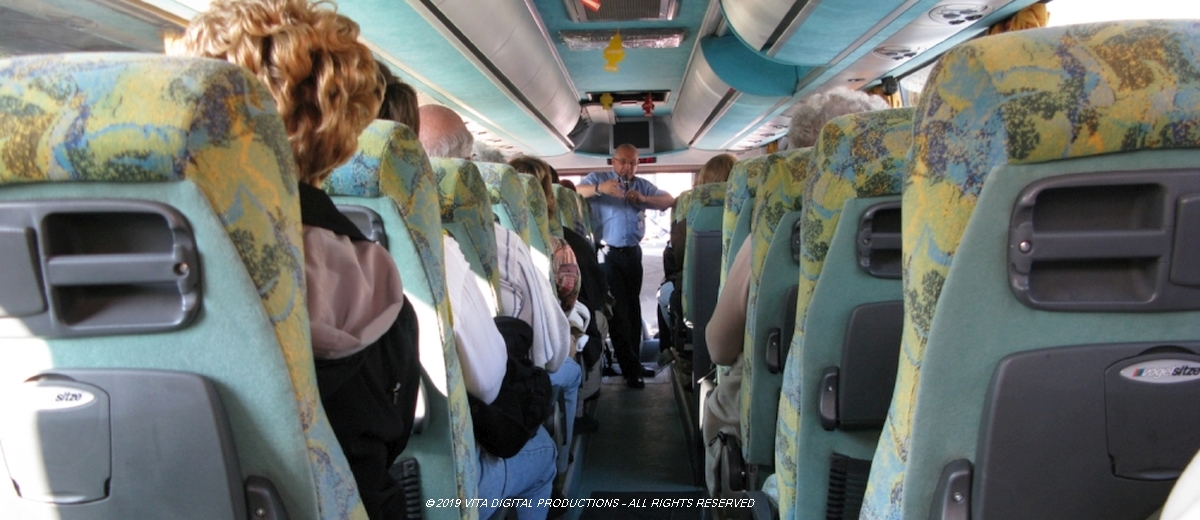
We signed on for all of the optional tours (except Alexandria, since I had been there in 1993 for several days); heard a lecture on ancient Egypt and 45 minutes later, were on the buses headed for the Cairo Antiquities Museum (NOTE: the museum is literally across the street from the Hilton, on the other side of a roundabout, but it's nearly a death-defying act to do it on foot!)
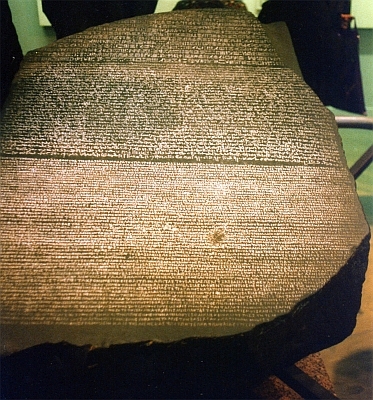
We stayed with Amin to listen to his lecture, given at the replica of the Rosetta Stone. Even though I did not know our guide at all well, I could see a slight trace of tears and hear the tremor in his rich voice as he most reverently spoke of this amazing sculpture. Of all the plundering and absolute thievery that has taken place down through the centuries, the Parthenon Marbles from the Acropolis and the Rosetta Stone from Cairo (both housed in the British Museum) are the two biggest disgraces, in my humble opinion. When we were in Greece, Wayne and I signed a petition demanding that England return the Parthenon Marbles to Athens. I would like to do the same with the Rosetta Stone which, when found in 1798 by Champollion during Napoleon's Egyptian campaign, unlocked the key to the ancient hieroglyphics. Before the deciphering of the code, the early explorers who happened upon these inscripted monuments could only view them as pretty pictures carved in limestone. What a find the Rosetta Stone was, and what a priceless gift to all of us to learn the ancient history of Egypt!
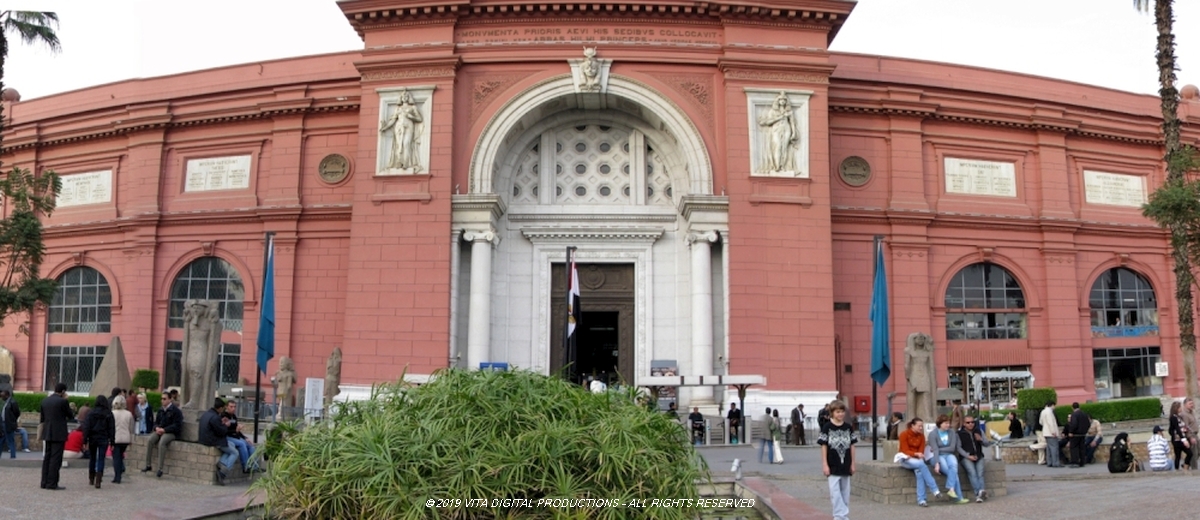
The Cairo Antiquities Museum is a grand old building erected in the early 1900s to house a few thousand objects. Today, it is home to 120,000 works of Eqyptian art and the presentation is less than desirable, to say the very least. I certainly do not blame the antiquities department, but rather the deplorable state of the country's economy. The museum desperately needs thermostatically-controlled display cases, better lighting, more presentation space and better security. Most objects are poorly labeled in Arabic and English. It makes one want to cry that these irreplaceable pieces of ancient art are, and have long been, in such peril. The good news is the planned opening of a new Antiquities Museum near Giza, projected for 2011. With Egypt's motto being “In sha 'alaah”, this date may be but a fanciful dream. (NOTE: As of 25 January 2018, Egyptian officials have just announced the relocation of the Ramses colossus to the atrium of the Grand Egyptian Museum, with the museum opening scheduled for later this year.)
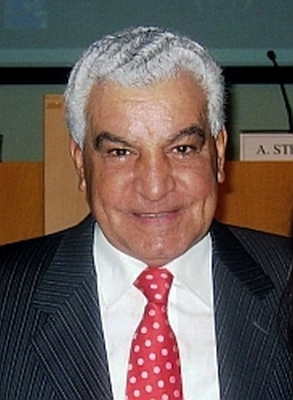
However, Egypt has an ace in the hole, a one-man crusader for the arts, the chairman of the Antiquities Council: Dr. Zahi Hawass. Nearly everyone in the western world who watches the Discovery Channel or the History Channel on TV knows this man. He is as passionate and as strong-willed an ambassador and agent for change as Egypt could have, and I applaud him for his herculean efforts to preserve Egypt's cultural heritage.
Wayne and I split off from the group and headed toward the second floor to see the Tutankhamun treasure trove.
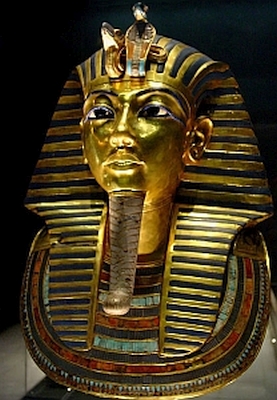
TRAVEL TIP: if you are visiting the Cairo Museum for the first time, make your way immediately up the grand staircase to the second floor to these rooms, and beat the crowd. You will not be disappointed. It goes without saying that I have never seen a more impressive display of golden treasure. Imagine all the artistry of the goldsmiths who fashioned the jewelry, the king's throne, the gold coffins, the high beds with leopards' and lions' heads, and – of course – the golden death mask of Tutankhamun.
As wonderful and as thrilling as it was to share this time with my husband, “mi ha bibi,” the absolute highlight of this visit to the Cairo Museum was its newest feature, the Mummy's Room. This second room (the first one opened in the 1990s) follows the design elements of a royal tomb, complete with vaulted ceiling. Eleven mummies are herein displayed, each one belonging to 20th Dynasty pharaohs and priests. There is a separate charge of 100 EGP (about $20) and it was a privilege to pay this meager sum to see such wonders: the actual faces of two of the greatest names in pharaonic history: Queen Hatshepsut and Ramsses II, known as Ramsses the Great. To stand mere inches from the actual faces of those two venerated rulers of ancient Egypt was, truly, like being a time traveler.
The thrill of seeing the inhabitants of The Mummy Room in Cairo was akin to my first walk down the streets of Pompeii all alone in January 1972. I am so humbled and thankful to have had the opportunity to experience this – wouldn't have missed it!
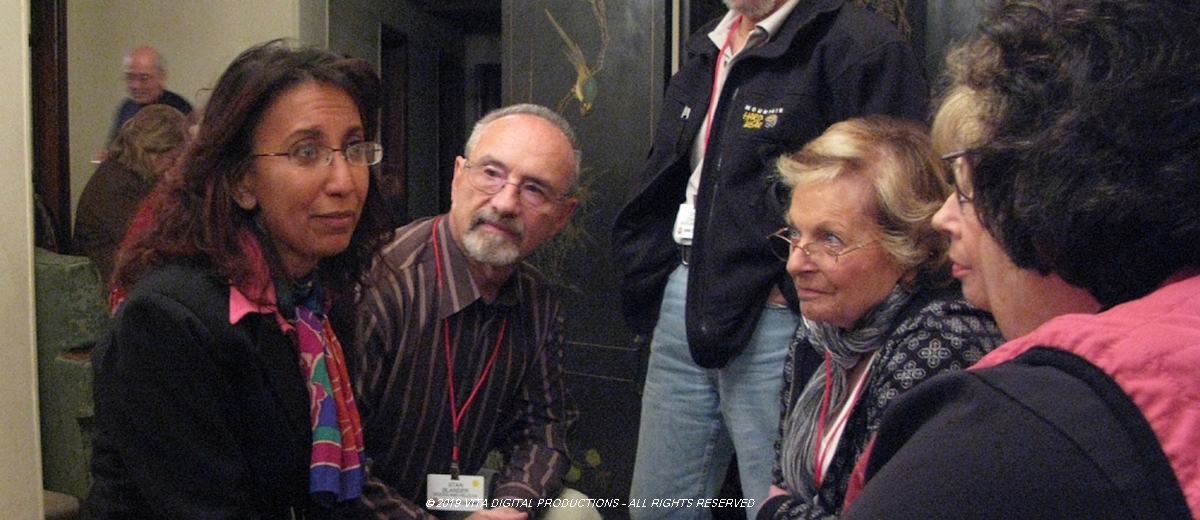
On New Year's Eve Wayne and I had another special experience: a home-hosted dinner with a family in Cairo. There were three generations present (the mother, Geda; her two teenaged sons; and her parents – very lovely and distinguished.) The meal we shared featured a typical Egyptian feast and really was delicious. We had beans, rice with cinnamon, falafel, phyllo pastries with cheese and olive filling, cauliflower, eggplant and green peppers stuffed with beef and chicken, peeled tomatoes and cucumbers, and yoghurt. For dessert we were offered cake with freshly-grated coconut and chocolate squares. It was a gracious and memorable evening, a truly happy feast (“a id' sa id' “) and such a wise way to unite the two continents. This is one of the best ways to achieve diplomacy and harmony between the West and the Middle East: face to face, and person to person.
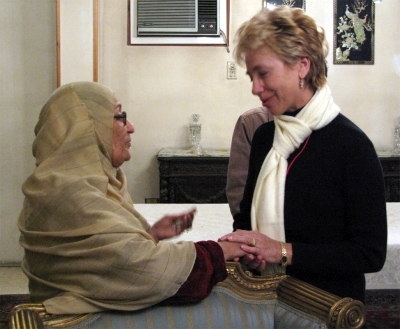
I had a long conversation with Geda's mother, a soft-spoken diminutive lady with an excellent command of English. We talked about family, customs in Egypt, and world peace – but mostly about family. This dear woman, in a very real sense, became a friend to me – and I think, I to her – in our brief exchange. I shall long remember her, and her kindness and most gracious hospitality extended to fifteen Americans in her home at the close of 2007...
Tuesday, New Year's Day 2008 Cairo - This morning as we were preparing to go down to breakfast, we watched the ball drop in Times Square to herald in the New Year in America. Here in Egypt we had already reached that mark 7 hours earlier, being in a different time zone. After breakfast we boarded our buses for Giza.
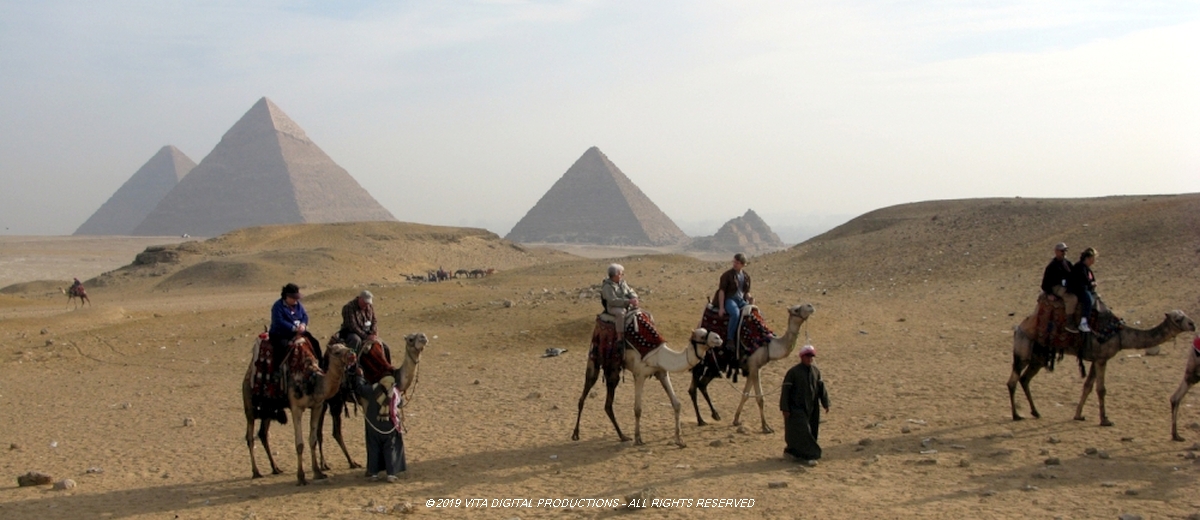
The Great Pyramids are – and always will be – a seminal moment in any world traveler's journeys. Cheops (father), Khefren and Chafre (sons) gave themselves glorious burial sites, as would befit gods on earth. They also gave all of us, in future millennia, a visual experience worth the price of a plane ticket halfway around the world. Wayne took the Sony and filmed a virtual walk while I climbed up 50 feet on Cheops' pyramid and took still pictures with the camera.
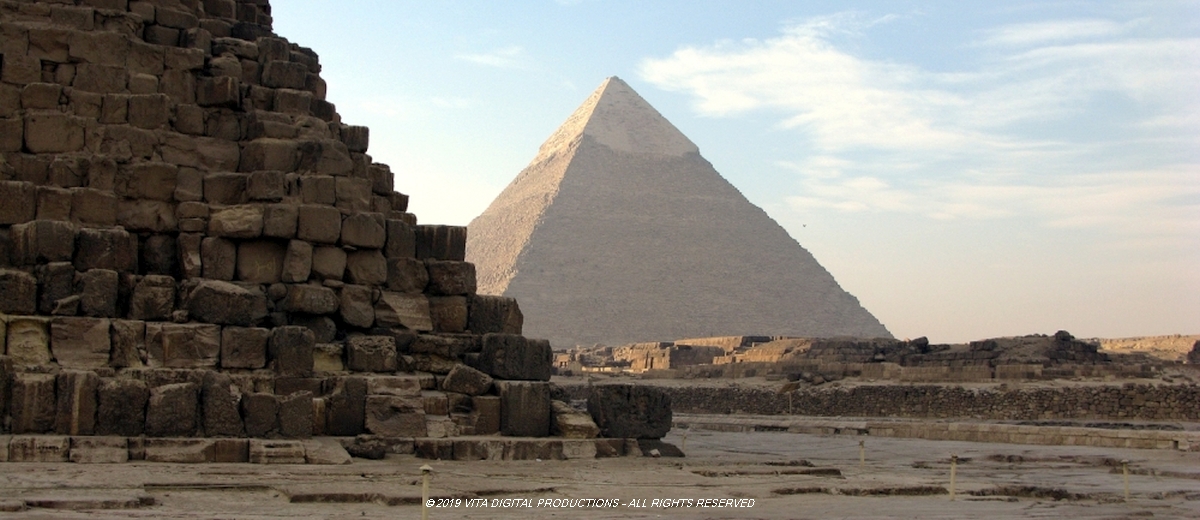
The Pyramid of Cheops is the oldest of the Seven Wonders of the Ancient World. When I was a little girl growing up in a small Virginia town, I would spend hours in the children's loft of our local library getting lost in historic time periods. There was so much to read and so many beautiful pictures to look at but, more than anything else, I was captivated even then by the sheer magnificence of Egypt. I dreamed of someday visiting this exotic land and seeing it for myself. My first opportunity to do so came in 1993, and I was not disappointed; if one remains open throughout one's life to discovery and adventure, then that keen interest will often be rewarded by rare and wonderful experiences.
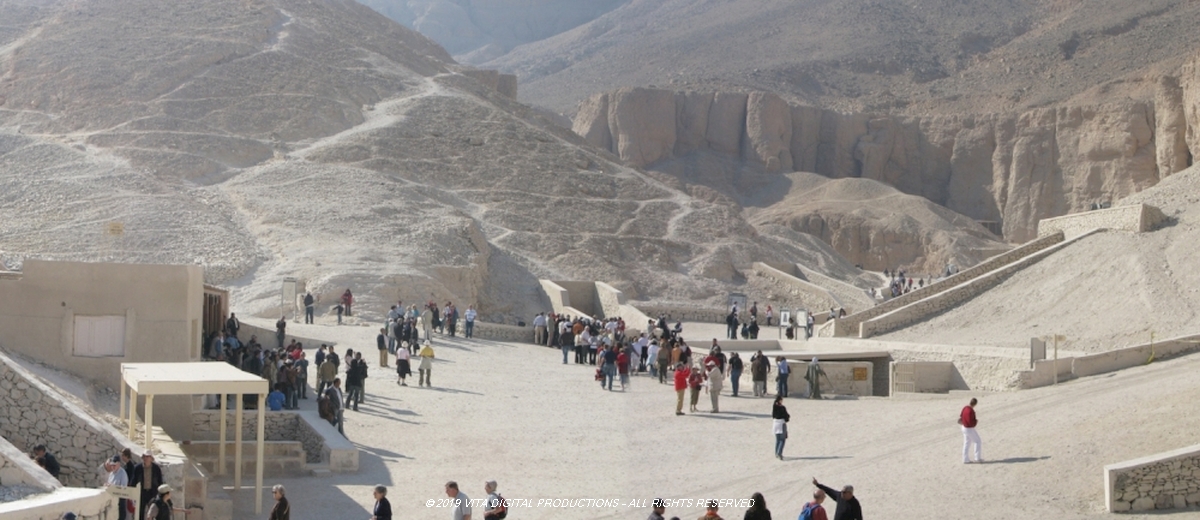
So very many time capsules from that first trip will burn in my mind's eye forever, but two in particular come to the forefront now. The first was in the Valley of the Kings on the West Bank of the Nile. Our group was very small, with only 7 people, and so we were able to gain entry into places usually closed to tourist groups. Because of our size we were able to gain entry into Tutankhamun's tomb and visit the boy king in situ. Having read Howard Carter's personal memoirs of his discovery of this intact tomb in November 1922, I literally trembled as I carefully and slowly walked down those 16 famous steps into Tutankhamun's resting place. Again, after having read and studied and talked about “King Tut” all of my life, one wonders if the actual moment will live up to the anticipation. Believe me... it did.
The second special memory of that first trip was our last night in Cairo . Three of us decided to return to the Giza Plateau one last time and asked our tour guide a favor; would it be possible for us to see the pyramids at sunset on horseback? Tarek made some enquiries and arranged for us to do just that! We spent two hours trotting and galloping up to and around the pyramids on fast Arabian mares, having the time of our lives...
TRAVEL TIP: If you are physically fit and adventurous and have the chance to go to Cairo, do yourself a favor and go for it! By evening, the day tourists and the hawkers are usually gone and, with luck, you will have the area uncluttered to enjoy. The condition of the horses is good, and you can book a stable rider to go along if help is needed.
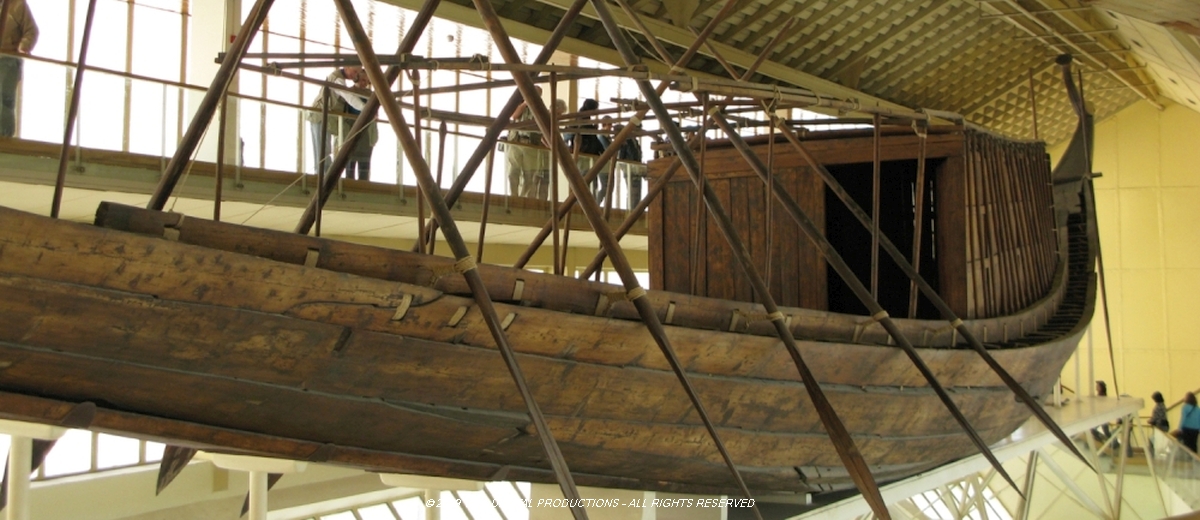
After Cheops we visited the Solar Boat Museum. This funeral ship was found on the south side of Khufu's pyramid and was opened to the public in 1985. This is an interesting side trip and one you will want to make as this boat can be viewed and studied from three different vantage points.
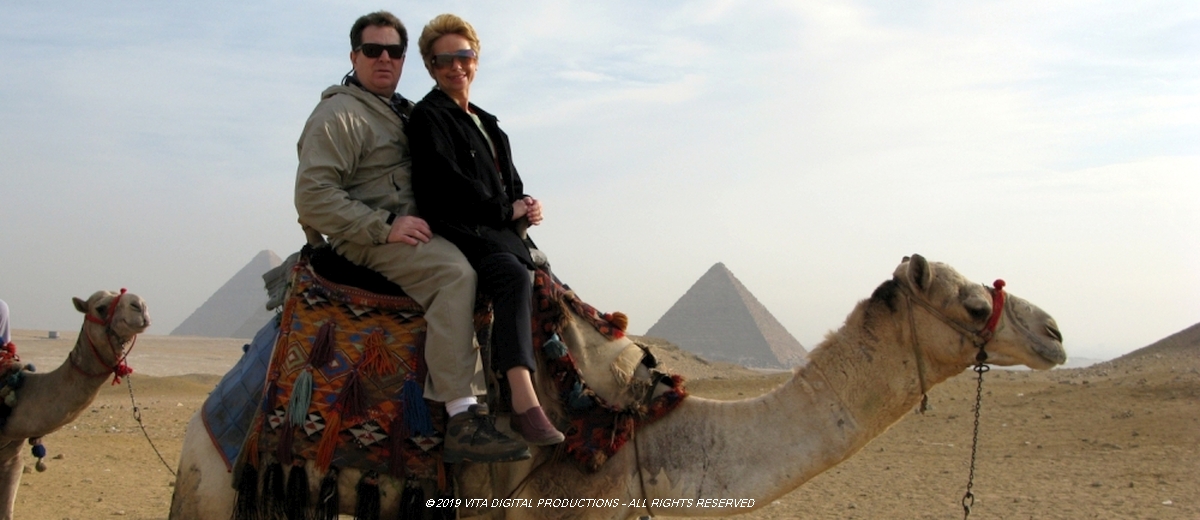
TRAVEL TIP: Do not miss the opportunity to ride a camel at Giza! Trust me, it really isn't as daunting as it sounds. There are short (less than a mile) rides that can be arranged with your guide or, for the truly daring, much longer overnight rides through the desert. Short or long, the vantage point from atop one of the “ships of the desert” is not to be missed.
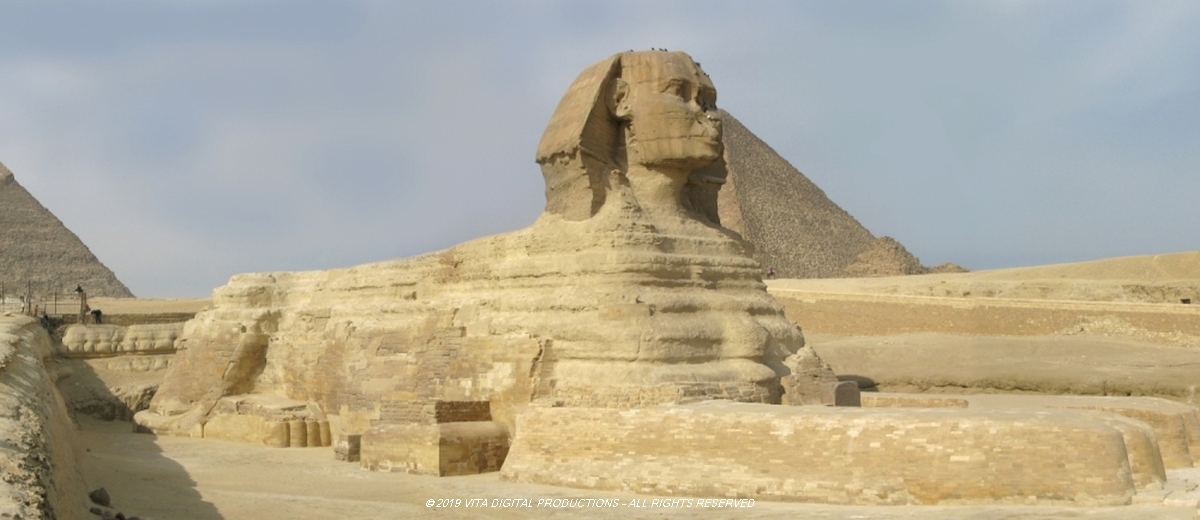
The final stop of the Giza trip was the Sphinx: massive, majestic and always enigmatic. This limestone statue represents a mythical creature half-lion and half-human. Of all the ancient sculptures in Egypt, the Sphinx is generally believed to date back to the Old Kingdom during the reign of the Pharaoh Khafre (c.?2558–2532 BC).
On those two trips to Egypt, I've had the chance to see it from many different perspectives, in many different natural light positions, at all times of the day and night. Once or twice I was even able to be almost alone physically with this magnificent embodiment of the ancient past.
TRAVEL TIP: Several others in our group were in the grips of Pharaoh's Curse by this time and headed back to the Hilton for a lie-down. So, if you start feeling queazy from stomach pain, it is perfectly acceptable, on a tour led by a licensed tour director, to ask if he or she has something available; quite often, the director will be able to assist you. Or, seek out a reputable pharmacy – there's almost always one nearby the 5-star hotels in the downtown area – and purchase Antinal, Panadol, Motinorm, or Rennie. One of these should cover any issues with nausea, indigestion or diarrhea.)
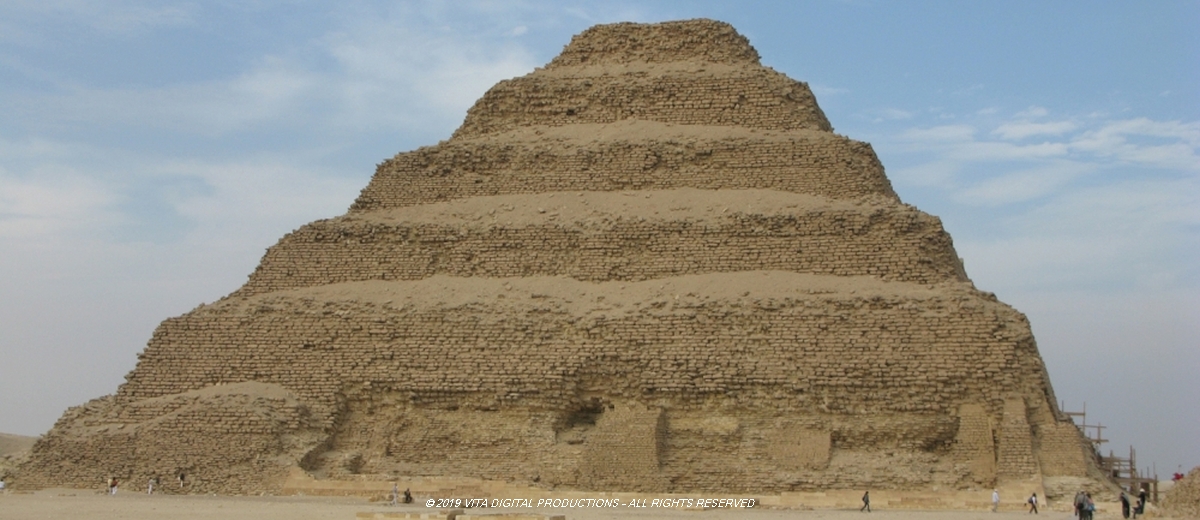
The rest of us went to the Mena House Oberoi for a lovely luncheon buffet (having a cast-iron stomach when traveling is a handy thing!) After a leisurely lunch we continued to Sakharra and the Step Pyramids. Built by the Egyptian architect, Imhotep, in six distinct layers or steps, this structure dates back to the 3rd Dynasty. The pyramid is the central feature of a vast mortuary complex in an enormous courtyard surrounded by ceremonial structures and decoration. Built of cut stone, innovative for its time period, Djoser's pyramid sets several important precedents. The process of building such a structure would have been far more labor-intensive than previous monuments of mud-brick. Thus, by the 27th century BC, we can infer that the royal state government had a new level of control of resources, both material and human. When constructed it stood at over 200 feet tall and was covered in gleaming polished white limestone: quite an impressive sight when set against the desert sands.
During the bus ride Amin gave us a bit of the history of the town of Sakharra. An artist living here in the early 1950s was concerned to see the children wandering aimlessly about the streets. At that time very few children had the opportunity to attend school, and so their future was usually relegated to dirt-poor farming. And so this artist began to gather children off the streets and into his own back yard where he taught them simple weaving, clay pottery design and some painting techniques. His little group expanded and over the next few years, he formed a carpet school with the most artistically-gifted youngsters. This was the beginning of the many carpet schools for which Sakharra is known today.
There followed a most interesting visit to one such carpet-making school. As always on these side trips, we were greeted with outstanding hospitality and a choice of hot or cold drinks. We chatted with the owner and director of the school and he then displayed handwoven silk carpets that caused us to gasp in wonder. As a cross-stitcher for many years who made bell pulls with 26 stitches to the inch, I could readily appreciate the craftsmanship of these carpets.
The public schools, run by the Egyptian government, require attendance by all children through the primary grades 1-6. These schools are very crowded and minimally staffed; it is not unusual for a class to have one teacher with 70-90 students. Schools are run on a double, half-day schedule; the first shift of children go to school from 8:00 AM-1:00 PM, and the second shift from 1:00-5:00 PM. Many of the children in the outlying villages attend one of the carpet schools to learn a trade. Also, many divorced and widowed Egyptian women attend carpet school 2-3 days per week and graduate after one year of instruction. The schools have an extension program which I find to be very practical. Schools supply their graduates with yarns and cotton or wool cloths so that they can weave from their homes. When they have completed a carpet or carpets, they bring them back to their school where they are offered for sale. The women receive 85% of the total sale, with the school director receiving a 15% commission.
We returned to the hotel at 5:00 PM. Our 4-bus caravan had its own police escort complete with siren and armed security officers ahead and behind us. This was courtesy of the Egyptian government and the service is provided to all large tour groups, a part of the governmental subsidy to support tourism. When someone in our group asked if the local Cairenes minded this preferential treatment, Amin replied that they didn't since it only caused local drivers a minute or so extra in traffic. They do, however, resent President Hosni Mubarrek's motorcades to and from his neighborhood in Heliopolis, since these are both lengthy and frequent.
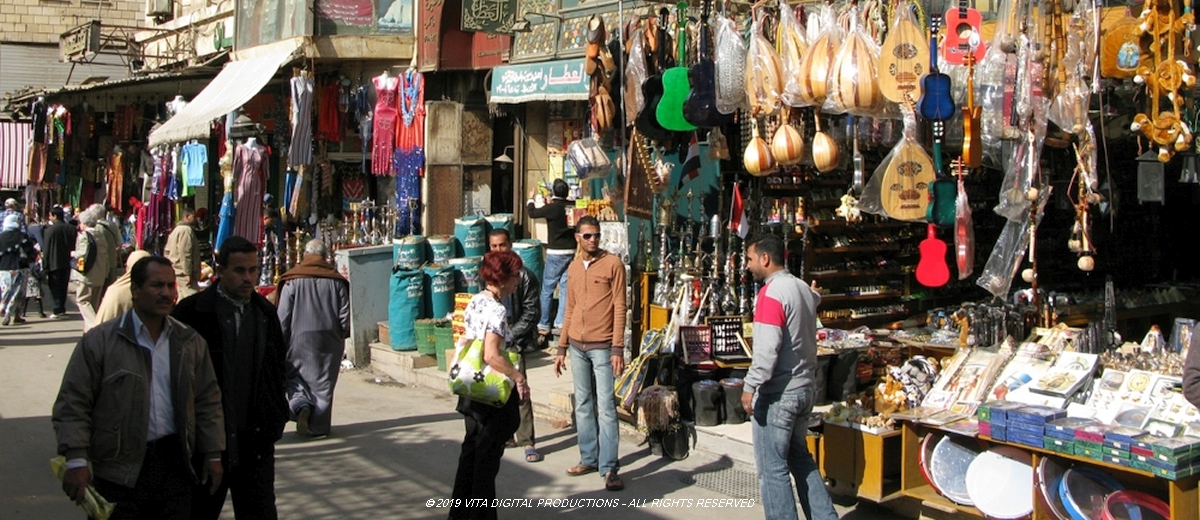
Wednesday, 2 January 2008 - We dressed and went down for a light breakfast at 8:00 AM. The majority of our group took the optional train trip to Alexandria. We decided to enjoy a day of rest at the hotel. This afternoon I did step out to visit a fruit shop nearby and there I had a nice little “conversation” with the girl running the shop. They are such nice people and I really enjoy every opportunity I have to interact with them. My Arabic is almost nonexistent but, over the years in foreign countries, I've learned that the bare minimum can get you by if you are polite and smile. The Egyptians always seem to light up whenever I say “salam alaikum” (which loosely translates to “peace be unto you”).
TRAVEL TIP: if you are greeted with this phrase the correct, polite response is “alaikum salam.”
Tonight we arranged for a taxi to give us a 30-40 minute ride across the Qasr El Nil Bridge, into Zamalek and back over the 6th October Bridge. The cost of this had been agreed upon as 40EGP – about $7.00. The driver of the little black-and-white cab was very nice and courteous. Wayne sat in the front beside the driver and I just enjoyed the drama of Cairo at night from the back seat. We tipped our driver $5.00 (about 27 EGP) and he seemed thrilled. He held traffic at bay and walked us back across the street to our hotel.
TRAVEL TIP: practice the Golden Rule wherever you go and appreciate the efforts to which service people will go on your behalf. Egyptians are, by their very nature, anxious to please and letting them know that you appreciate those efforts goes a long way.
Thursday, 3 January 2008 - This morning we've been in old Cairo. Amin gave us a heartfelt lecture on Islam and the beliefs and lifestyle of Muslims, who make up 90% of the Egyptian population.
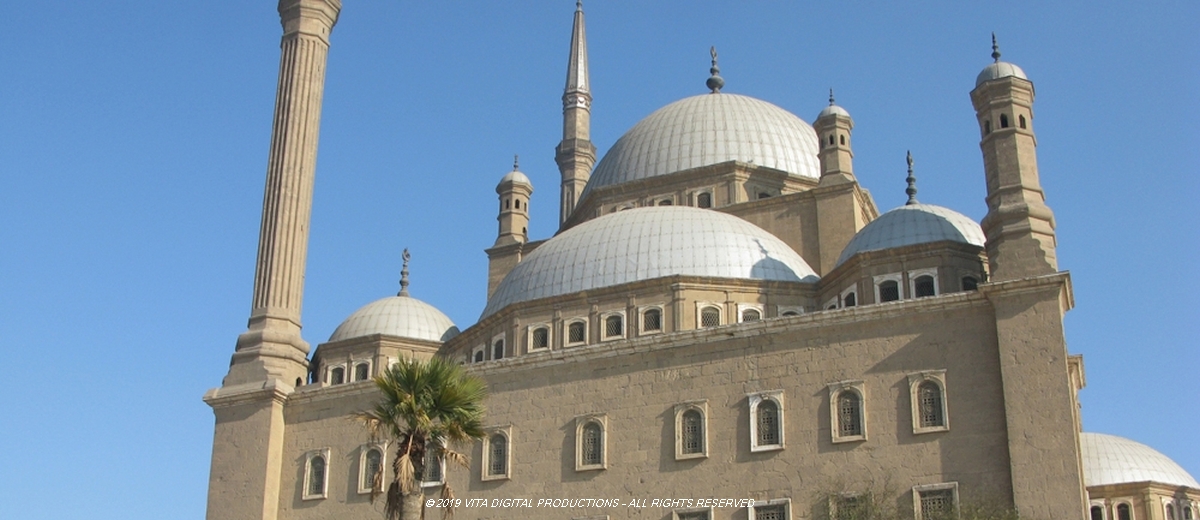
We were all seated in the Mohamed Ali Mosque – also known as the Alabaster Mosque – on Egyptian carpets. Even with the number of people in the mosque, there was enough space between groups that each lecturer could easily be heard. Mohamed Ali, though not an educated man, was a true leader of his people and is well-respected and admired by modern day Egyptians.
Continue Reading About This Trip in Our Blog, "Nile - Once in a Lifetime."
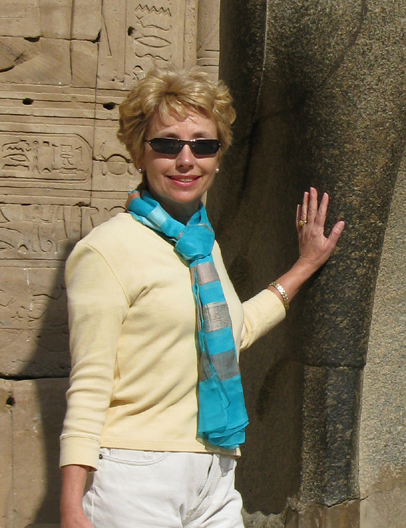
About the Author - Kathi Jacobs and her husband, Wayne, are the owners of VITA Digital Productions, a video production company specializing in creating Virtual Walks, Virtual Jogs, Virtual Cycling Scenery, and Virtual Cruises on scenic rivers. With over 50 different Virtual Experience Videos to choose from on vitadvds.com, VITA Digital Productions is the leading producer of Virtual Experience Videos in the world.